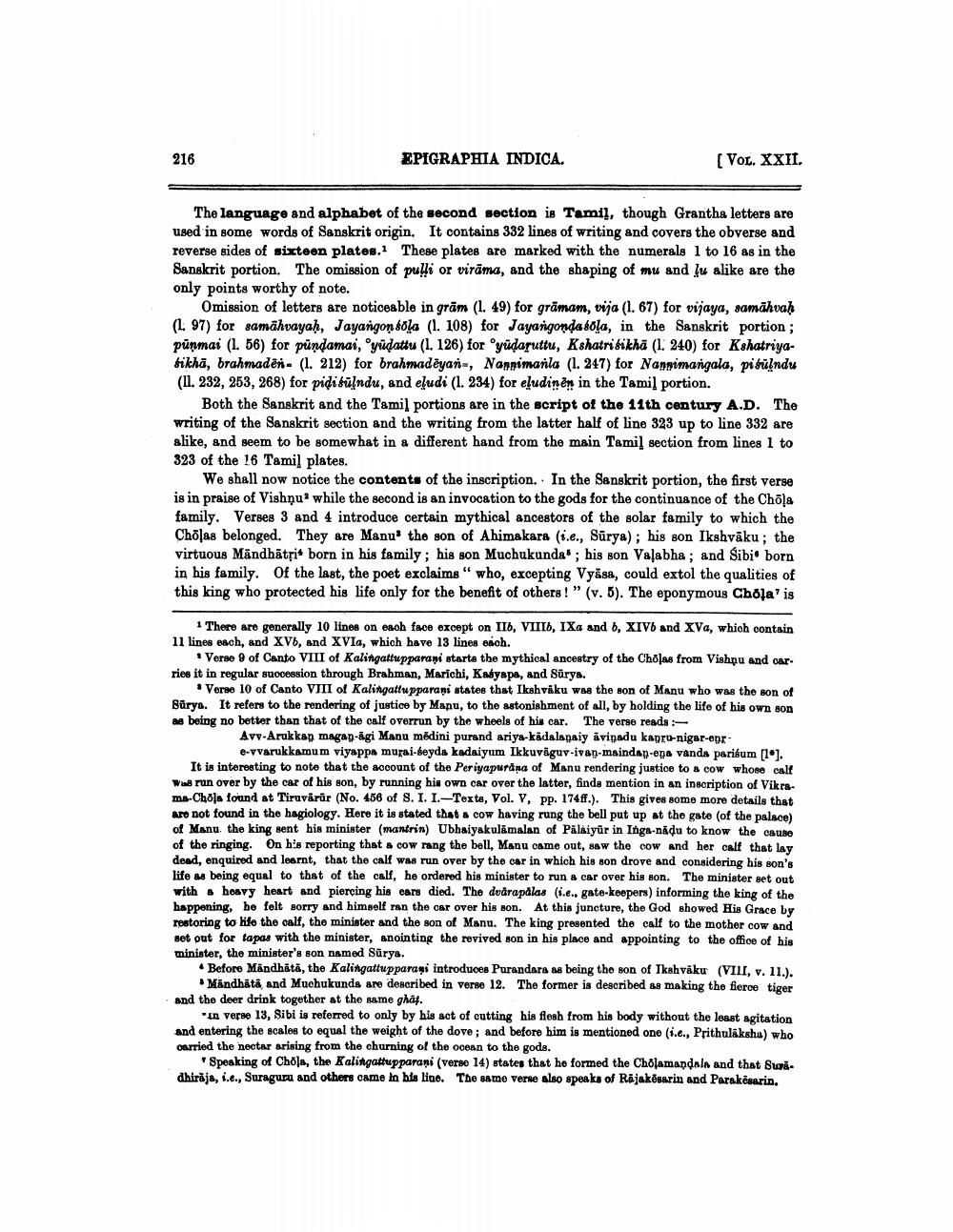________________
216
EPIGRAPHIA INDICA.
(VOL. XXII.
The language and alphabet of the second section is Tamil, though Grantha letters are used in some words of Sanskrit origin. It contains 332 lines of writing and covers the obverse and reverse sides of sixteen plates. These plates are marked with the numerals 1 to 16 as in the Sanskrit portion. The omission of pulli or virāma, and the shaping of mu and Ju alike are the only points worthy of note.
Omission of letters are noticeable in grām (1. 49) for grāmam, vija (1. 67) for vijaya, samāhvah (L. 97) for samāhvayah, Jayangonbola (1. 108) for Jayangonda fola, in the Sanskrit portion; pünmai (1. 56) for pundamai, 'yüdattu (1. 126) for 'yüdaruttu, Kshatrifikha (1. 240) for Kshatriyabikha, brahmaden - (1. 212) for brahmadēyan-, Nannimanla (1.247) for Nannimangala, pisülndu (11. 232, 253, 268) for pidisülndu, and eludi (1. 234) for eļudinen in the Tamil portion.
Both the Sanskrit and the Tamil portions are in the script of the 11th century A.D. The writing of the Sanskrit section and the writing from the latter half of line 323 up to line 332 are alike, and seem to be somewhat in a different hand from the main Tamil section from lines 1 to 323 of the 16 Tamil plates.
We shall now notice the contents of the inscription. In the Sanskrit portion, the first verse is in praise of Vishnu' while the second is an invocation to the gods for the continuance of the Cho! family. Verses 3 and 4 introduce certain mythical ancestors of the solar family to which the Chēļas belonged. They are Manu' the son of Ahimakara (i.e., Sürya); his son Ikshvāku ; the virtuous Mändbātri. born in his family; his son Muchukunda; his son Valabha; and Sibi. born in his family. Of the last, the poet exclaims" who, excepting Vyasa, could extol the qualities of this king who protected his life only for the benefit of others!" (v. 5). The eponymous Chola' is
1 There are generally 10 lines on each face except on IIb, VIII, IXa and b, XIV. and XVa, which contain 11 lines each, and XV6, and XVIa, which have 13 lines each.
Verse 9 of Canto VIII of Kalingattupparami starts the mythical ancestry of the Cholas from Vishnu and car. ries it in regular succession through Brahman, Marichi, Kayapa, and Sūrys.
Verse 10 of Canto VIII of Kalingattupparani states that Ikahvaku was the son of Manu who was the son of Sürya. It refers to the rendering of justice by Mapu, to the astonishment of all, by holding the life of his own son as being no better than that of the calf overrun by the wheels of his car. The verse reads
Avv-Arukkap magan-agi Manu modini purand ariya-kadalanaiy ivinadu kapru-nigar-opr.
e-vvarukkamum viyappa murai-beyda kadaiyum Ikkuväguv-ivan-maindan-ena vånda parisum [lo]. It is interesting to note that the account of the Periyapurana of Manu rendering justice to & COW whose call ww run over by the car of his son, by running his own car over the latter, finds mention in an inscription of Vikrams.Chola found at Tiruvarur (No. 456 of 8. II.-Texte, Vol. V, pp. 174ff.). This gives some more details that are not found in the hagiology. Here it is stated that a cow having rung the bell put up at the gate (of the palace) of Manu, the king sent his minister (mantrin) Ubhaiyakulamalan of Palaiyur in Inga-nidu to know the cause of the ringing. On his reporting that a cow rang the bell, Manu oame out, saw the cow and her calf that lay dead, enquired and learnt, that the calf was run over by the car in which his son drove and considering his son's life as being equal to that of the calf, he ordered his minister to run a car over his son. The minister set out with a heavy heart and piercing his ears died. The dvdrapålas (i.e.. gate-keepers) informing the king of the happening, he felt sorry and himself ran the car over his son. At this juncture, the God showed His Grace by restoring to life the calf, the minister and the son of Manu. The king presented the call to the mother cow and set out for tapas with the minister, anointing the revived son in his place and appointing to the office of his minister, the minister's son named Sürya.
Before Mandhätā, the Kalingattuppara i introduces Purandara as being the son of Ikahvaku (VIII, v. 11.).
Mändhati and Muchukunds are described in verse 12. The former is described as making the fierce tiger and the deer drink together at the same ghaf.
In verse 13, Sibi is referred to only by his act of cutting his flesh from his body without the least agitation and entering the scales to equal the weight of the dove; and before him is mentioned one (i.e., Prithulakshu) who oarried the nectar arising from the churning of the ocean to the gods.
Speaking of Chole, the Kalingattupparani (verse 14) states that he formed the Cholamandala and that swa. dhiraja, i.e., Suraguru and others came in his line. The same verse also speaks of Rajakosarina and Parakesarin,




